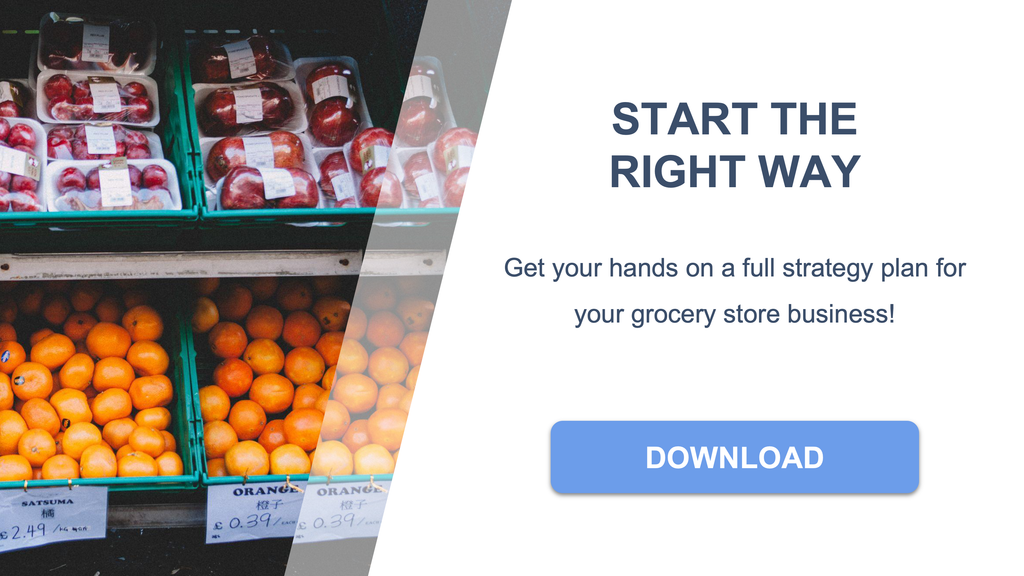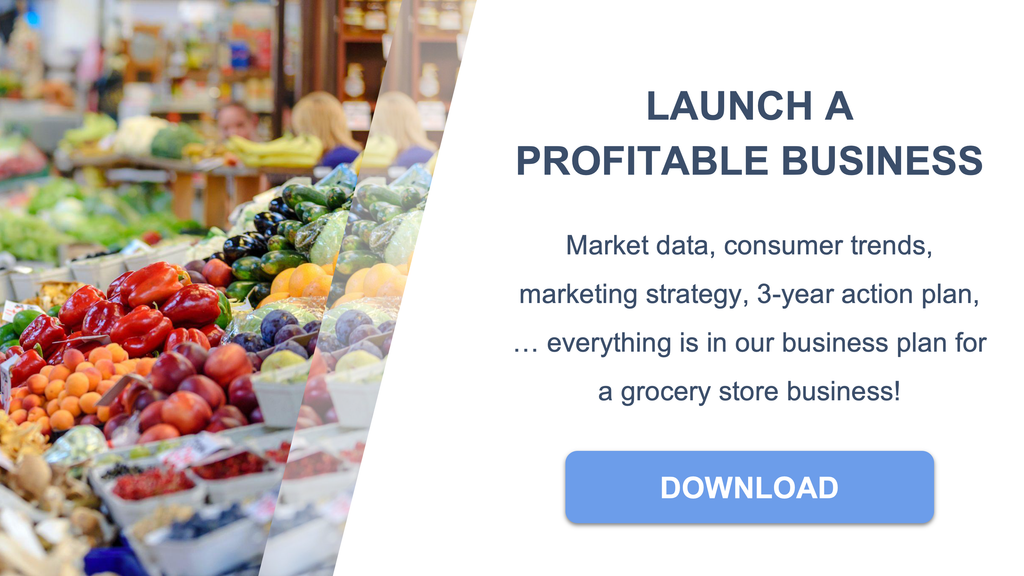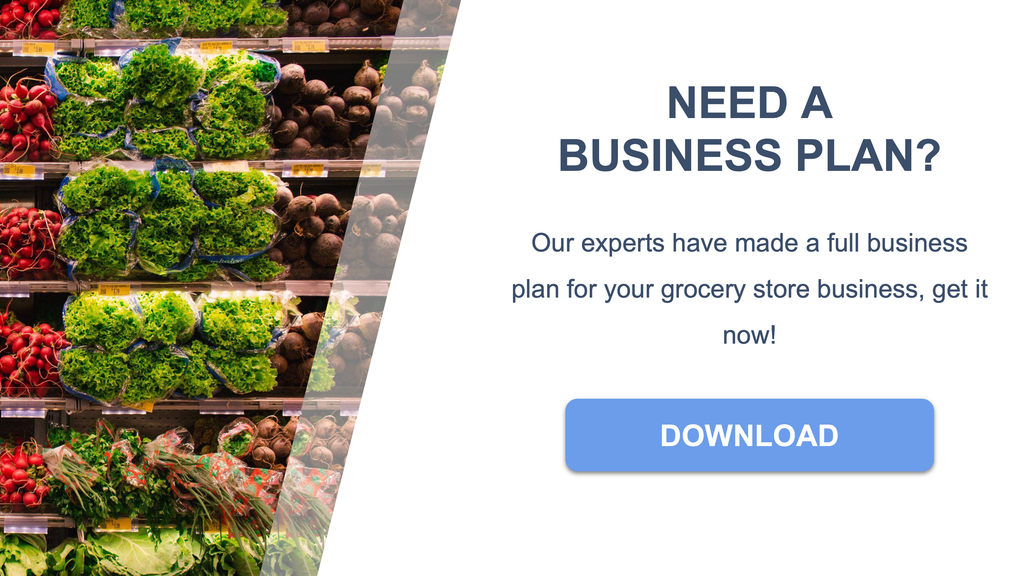
Get a watermark-free, fully customizable business model canvas in our business plan for a grocery store
In the dynamic landscape of retail, having a clear and effective strategy is essential for the success of your grocery store.
Welcome to your detailed walkthrough of the Business Model Canvas, customized for grocery store owners and managers.
This guide will deconstruct the framework into manageable pieces, allowing you to pinpoint your unique value proposition, understand your customer base, map out key operations, and much more.
Should you be looking for a ready-to-use Business Model Canvas that's fully customizable, don't hesitate to explore our business plan template designed specifically for a grocery store venture.
What is a Business Model Canvas? Should you make one for your grocery store?
A business model canvas is a strategic management and entrepreneurial tool that allows you to describe, design, challenge, invent, and pivot your business model.
Imagine it as a structured visual representation that details the various elements of a grocery store's operations, such as the products you offer, your customer relationships, and your revenue streams.
In the context of a grocery store, the canvas serves as a map that illustrates how your store intends to attract and serve customers, what kind of products you'll stock, and how you'll manage your finances.
Why do people create a business model canvas? For grocery store owners, it's about gaining a clear and succinct view of the essential aspects of their business. It's a tool for understanding how you'll bring value to your customers, differentiate yourself from competitors, and keep your business economically viable.
For a grocery store, this might involve detailing your range of local or organic products, your customer loyalty programs, your marketing tactics, and how you manage your supply chain and costs.
The benefits are substantial.
It promotes strategic planning and helps you concentrate on the core aspects of your business. It can reveal unforeseen challenges or opportunities, allowing you to refine your approach before you fully commit to your business plan.
For example, you may discover that your plan to focus on high-end gourmet products may not resonate in a community that values budget-friendly shopping. This insight could prevent costly missteps.
Should you create one if you're starting a new grocery store project? Definitely.
It's an essential part of the planning process that can steer your decision-making and strategies. It enables you to clearly present your vision to potential investors or partners. A well-thought-out business model canvas, similar to the one you can find in our business plan template tailored for a grocery store, can transform a risky idea into one that's supported by a strategic market analysis.
Is it useful for you? Without a doubt, especially if you aim to establish a clear plan for your grocery store. It compels you to methodically work through your business model and assess the practicality of your grocery store concept.
Moreover, it's a dynamic document that you can modify as your grocery store expands or as the market evolves.

How to create a Business Model Canvas for your grocery store?
Creating a Business Model Canvas for your grocery store should be straightforward.
You can simply adapt the one we have already crafted and filled in our business plan template tailored for a grocery store.
Looking for more specifics? Let's dissect each section of the canvas, and I'll walk you through how to complete it with practical ideas and inspiration, using a clear and concise method.
Value Proposition
Let's start with the Value Proposition.
This is the core of your grocery store. What sets your store apart? Is it the local and organic produce, the convenience and location, or perhaps the variety of international foods?
Consider what will draw customers to your store instead of another. It might be your commitment to sustainability, a wide selection of hard-to-find specialty items, or a focus on community-centric events and workshops.
Customer Segments
Moving on to Customer Segments.
Who are your shoppers? Are you catering to health-conscious individuals, busy families in need of quick meal solutions, or gourmets looking for premium ingredients?
Knowing your target audience will influence many of your choices, from product selection to the services you offer.
Channels
Now, let's talk about Channels.
How will you connect with your shoppers? This might include a combination of digital and physical avenues.
Think about leveraging social media for promotions, a website for online shopping and delivery options, and traditional methods like local flyers and community bulletin boards to engage with the neighborhood.
Remember the importance of in-store experience and consider how you can make shopping at your store memorable and convenient.
Customer Relationships
Customer Relationships are about how you engage with your shoppers to ensure they return.
Focus on excellent customer service, loyalty programs, and responding to customer feedback.
Explore how technology can improve the shopping experience, such as through a mobile app for personalized offers or a self-checkout system to reduce wait times.
Revenue Streams
In the Revenue Streams section, you'll think about how your grocery store will generate income.
Beyond product sales, consider additional streams like delivery services, membership fees for exclusive deals, or hosting cooking classes and nutritional workshops.
Get inventive and think about what aligns with your brand and customer needs.
Key Activities
On the flip side of the canvas, we have Key Activities.
These are the critical tasks required to run your grocery store. This includes stocking shelves, managing inventory, customer service, and ensuring a clean and welcoming environment.
Identify the activities that are vital to delivering your value proposition and how you can perform them effectively.
Key Resources
Key Resources are the assets essential to your value proposition.
This encompasses your inventory, employees, supplier relationships, and even your store's layout and location. Reflect on what you need to make your grocery store thrive and how you can obtain these resources.
Key Partnerships
Key Partnerships could involve local farmers, product distributors, or collaborations with other local businesses that can help you mitigate risks or access resources.
For example, partnering with a local bakery or a community garden can provide you with unique products that differentiate your store from competitors.
Cost Structure
Finally, Cost Structure.
Operating a grocery store comes with various expenses, from lease and payroll to procurement and utilities. Understanding these will aid in managing your finances effectively.
It's crucial to distinguish between fixed costs, like lease payments, and variable costs, such as inventory purchases, to budget properly.
What should be included in each section of the Business Model Canvas for a grocery store?
Unsure about how to complete the Business Model Canvas for your grocery store? You might want to consider using the template we've provided in our business plan template.
Here's a guide with examples to assist you in filling out each section of the Business Model Canvas for a grocery store.
| Component | Examples |
|---|---|
| Key Partners | Local farmers and producers, Wholesale distributors, Cleaning services, Inventory management software providers, Security service providers |
| Key Activities | Stocking and restocking shelves, Managing inventory, Providing customer service, Processing payments, Implementing sales and promotions |
| Key Resources | Storefront location, Shelving and refrigeration units, Shopping carts and baskets, Point of Sale (POS) system, Employee expertise |
| Value Propositions | Wide range of products, Competitive pricing, Fresh local produce, Convenient location, Membership discounts |
| Customer Relationships | Friendly in-store assistance, Membership programs, Weekly flyers and coupons, Community events, Online support |
| Channels | Physical store, Online grocery platform, Mobile app, Email newsletters, Local advertising |
| Customer Segments | Local residents, Price-sensitive shoppers, Health-conscious consumers, Bulk buyers, Specialty product seekers |
| Cost Structure | Inventory purchase costs, Employee wages, Store maintenance, Utilities and rent, Marketing and advertising expenses |
| Revenue Streams | In-store sales, Online grocery orders, Delivery fees, Bagging service tips, Loyalty program subscriptions |

Examples of Business Model Canvas for a grocery store
Below are examples of business model canvases for three different types of grocery stores: Organic Grocery Store, Discount Grocery Store, and Ethnic Grocery Store.
Organic Grocery Store Business Model Canvas
| Component | Description |
|---|---|
| Key Partners | Organic farmers, local producers, sustainable product vendors |
| Key Activities | Sourcing organic products, inventory management, customer education |
| Value Propositions | High-quality organic goods, environmentally friendly practices, health-conscious options |
| Customer Relationships | Knowledgeable staff, community workshops, loyalty programs |
| Customer Segments | Health-conscious consumers, environmentally aware individuals, organic product enthusiasts |
| Key Resources | Organic certification, knowledgeable employees, retail space |
| Channels | In-store shopping, online store, home delivery services |
| Cost Structure | Premium product costs, employee training, certification fees, marketing |
| Revenue Streams | Sales of organic products, delivery service fees, educational workshop fees |
Discount Grocery Store Business Model Canvas
| Component | Description |
|---|---|
| Key Partners | Bulk suppliers, discount product vendors, local businesses for promotions |
| Key Activities | Stocking affordable goods, efficient checkout processes, sales promotions |
| Value Propositions | Low prices, wide variety of products, convenient shopping experience |
| Customer Relationships | Self-service environment, weekly deals, customer service desk |
| Customer Segments | Budget-conscious shoppers, families, small businesses seeking bulk purchases |
| Key Resources | Warehouse-style store layout, point-of-sale systems, inventory management software |
| Channels | In-store shopping, weekly flyers, email newsletters |
| Cost Structure | Volume purchasing, minimal staffing, low-cost marketing |
| Revenue Streams | Sales of discounted goods, in-store promotions, private label products |
Ethnic Grocery Store Business Model Canvas
| Component | Description |
|---|---|
| Key Partners | Importers of ethnic products, local ethnic farms, cultural associations |
| Key Activities | Importing specialty products, hosting cultural events, community outreach |
| Value Propositions | Authentic ethnic products, cultural connection, unique shopping experience |
| Customer Relationships | Personalized service, cultural events, cooking classes |
| Customer Segments | Immigrant communities, food enthusiasts, people seeking cultural goods |
| Key Resources | Specialty product knowledge, relationships with importers, ethnic community ties |
| Channels | In-store shopping, cultural festivals, social media |
| Cost Structure | Import costs, event organization, community engagement efforts |
| Revenue Streams | Sales of ethnic products, event participation fees, cooking class charges |

You can also read our articles about:
- how to build a marketing strategy for your grocery store
- how to segment the customers of your grocery store
- how to make a competition study for your grocery store
- how to open a grocery store (guide)
